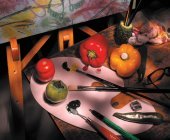|
Camera LensCamera lens is the most important part of a camera. A lens is classified by its focal length. Focal length of a lens is that distance (in millimeter), from film plane to the noddle point of the lens, when the focused object, is placed at infinity distance. Long focal lengths (read more about telephoto lens) covers less angle of image area than their short focal length counter part (wide angle lens).
Another consideration is a speed of a lens. A lens is considered as a fast lens, if the maximum opening of aperture is wider (f no. is smaller). So a lens with f1.4 is faster (and costlier) compared to f2.
Lenses designed to go closer to the subject for close-up photography are Macro-lens. They are designed to deal with problems related to close focusing. Read more about close-up photography in detail.
Some tele-lens contain mirror instead of glass elements. These lenses are catadioptric lenses, which could be 500mm and beyond. They are very convenient to use as their physical body length is very short and they are very light in weight compared to those lenses with glass elements. These lenses are free from chromatic aberration as they work on physics of reflection and not refraction of light. However, aperture ring cannot be provided in these lenses so they are normally calibrated to f8 or f11 fixed aperture. Some camera lens can be shifted from its axis, for correcting perspective and converging lines. They are known as perspective control lens or PC lens. All lenses in an SLR can be modified for their optics, with an attachment, either in front of the lens, or between the lens body and the camera body. In front, we can fix close-up lenses available in different power. We can also fix a mirror attachment to take candid photographs. In-between the camera and a lens-body, we can fix a tele-converter and distance rings. Tele-converters will multiply the focal length of any lens by its factor - 1.4x or 2x. So if we attach 2x on 50 mm lens, the lens will become 100 mm lens. Distance rings are hollow barrels, which are available in different lengths like 20mm or 40mm (refer the manufacturer). They can be used (in series also) to bring the camera closer to the subject for close-up photography. Reversal ring is another attachment, which allows us to use a normal-lens other way on a camera body so the front becomes back and the back element comes in front. This modification gives superb sharpness for close-ups photography. Ordinary camera lens has number of faults. Good quality lens is corrected for faults, during designing. The common faults are flare, chromatic aberration, spherical aberration, distortion, field curvature and diffraction. Correction of these faults affects costing of camera lens. Read about these lens faults in detail: Blur or defocus of lens: Blurring of an image due to lens fault Chromatic aberration: How chromatic aberration or distortion affects the image quality Diffraction: Scattering of light causing diffraction in an image Field curvature: Field curvature aberration of a lens
Lens flare: How to take care of a lens flare Loss of contrast: How ability of capturing contrast of a lens is lost
Optical distortion: Physics of optical distortion and how to check it Spherical aberration: Optics of spherical and asherical lens
Read about how to test a camera lens
Auto focus mechanism of camera
Other photographic accessories
Return back to camera from camera lens
|






